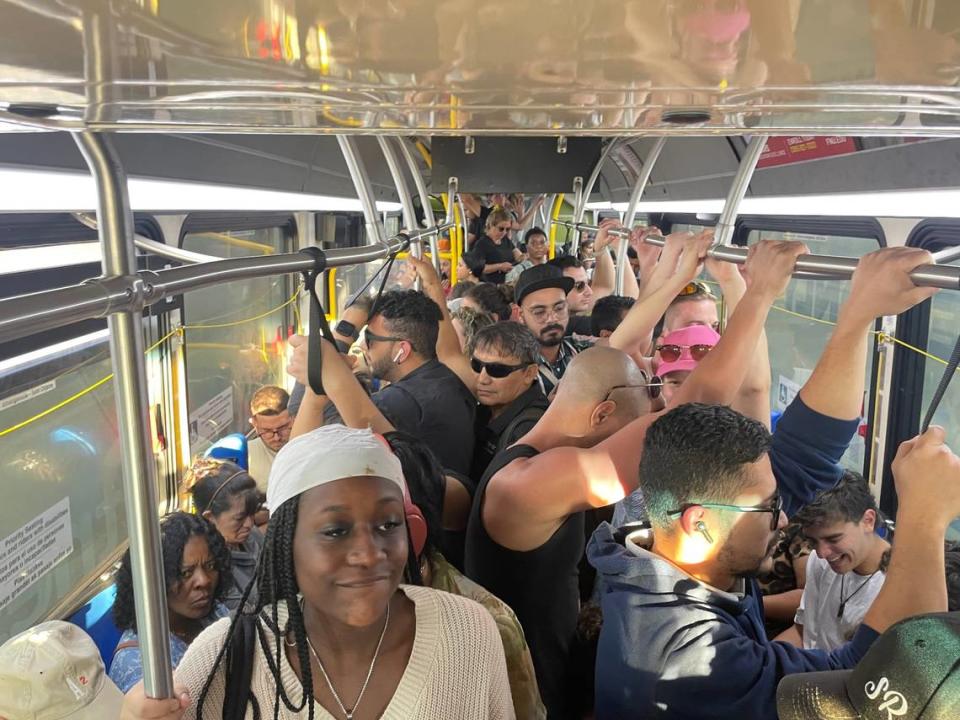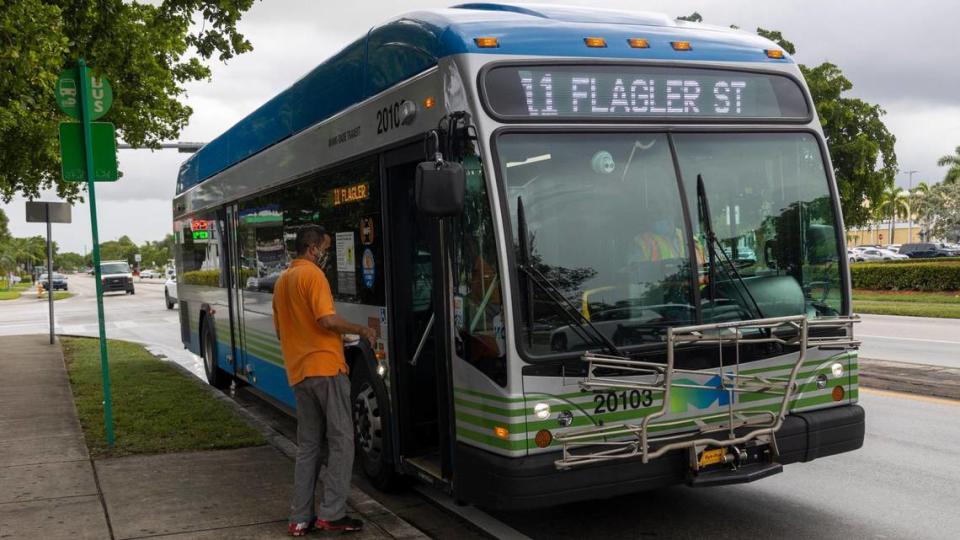Can Miami-Dade County finally streamline its public bus service, reduce waiting time?
Though hobbled by staffing shortages, Miami-Dade County’s transit arm says it is finally ready to implement a reworking of bus routes that eliminates hundreds of stops while reducing wait times on popular routes.
Launched in 2018 with town halls, workshops and surveys, the Better Bus Network originally was pitched as shifting staff dollars from routes with fewer riders to ones where the buses are frequently crowded.
READ MORE: A dive into Miami-Dade County’s Better Bus plan and what it means for passengers
In 2021, Mayor Daniella Levine Cava won approval of the plan by backing away from the reductions and promising $27 million in extra staffing to retain less popular routes while increasing service on busy commuting corridors.
Now the strategy is back to keeping the bus division’s budget mostly flat while counting on route changes and other moves to make the Better Bus plan work. Key to that is the county’s slimmed-down bus schedule that’s already in place.

The administration said cuts imposed during the plunge in transit ridership brought on by the coronavirus pandemic have made it easier for the county to implement a modified version of the plan with only limited additional reductions.
“We have right-sized the service,” said Linda Morris, chief of planning and scheduling for transit in Miami-Dade’s Department of Transportation and Public Works. “We want to make sure we’re not putting operators out where we don’t need them to be.”

More people ride buses than fly out of MIA in a day
If given the green light by county commissioners, the Better Bus Network will mean changes throughout a bus network that, according to Miami-Dade statistics, carries more passengers on an average day (103,000 boardings) than the number of people who board planes at Miami International Airport (70,000 boardings).
Three times times more popular than Metrorail, which records about 31,000 boardings a day, Miami-Dade’s bus system is also burdened by long waits between bus arrivals and stops busy enough that operators frequently drive past them with buses too full to take on more passengers.

“The thing that keeps people from using transit is you have to wait 45 minutes or an hour for a bus,” said Marta Viciedo, co-director of the Transit Alliance Miami, a non-profit that helped design the original Better Bus plan and now is helping promote the newest version to the community under a $226,000 county contract. “Frequency is the key... It helps people actually rely on transit on a day-to-day basis.”
The Better Bus plan increases distances between bus stops, adds some routes and deletes others. The result should be a more dependable and convenient network for those who live near the upgraded routes, and the most extensive redesign of county bus service since the 1980s.
A June 14 memo from Levine Cava said 20% of the county’s low-income population currently lives within a half mile of a high-frequency route, compared to 40% under the new route system.
Driver shortage proved to be one obstacle
Once set to start in 2021 when launched by then-Mayor Carlos Gimenez and then last year under Levine Cava, the current administration blamed hiring shortages in pausing the plan until transit could find more operators. The administration said last year it needed 400 more operators to make the plan work.
But with the national labor crunch for transit operators continuing to include the Miami area — Miami-Dade’s bus division has about 9% fewer bus drivers than it did at the start of the pandemic — the administration said it can still make the Better Bus plan work with some tweaks.
Now scheduled for a November launch, Levine Cava said the modified plan delivers 94% of the service hours in the original plan. Some of the planned new routes have been eliminated, as have existing ones that were spared when commissioners approved the final network in October 2021.
“The BBN transforms the bus network of Miami-Dade County from one that provides a basic service to every corner of the county to one that provides more reliable and frequent service for a greater number of riders,” Levine Cava wrote.
Speedier arrivals depend in part on passengers walking farther to meet the bus.
The plan includes eliminating nearly 2,000 of the county’s 8,000 bus stops. Spokesperson Juan Mendieta said Monday that about 700 of them have already been removed in recent years, with about 1,200 left to drop once the plan goes into effect.
For Matthew Gultanoff, a Miami Beach resident, the new plan has a welcome change and one that’s expected to bring some frustration.
The non-profit executive and founder of Better Streets Miami Beach should be able to count on shorter waits for bus rides downtown, with the renamed 100 route replacing the 120 with buses arriving every eight minutes throughout the day. That’s an improvement over the current 15-minute wait outside of rush hours.
“For me and my family,” Gultanoff said, the Better Bus plan “means more options heading west to the mainland and less chances of buses being full.” But the planned reduction of frequency in the 150 bus will leave that route from Miami International Airport “less useful” for residents.

Here are some notable changes in the proposed Better Bus Network plan:
▪ Prepare for new names: Part of the redesign involves dropping route names tied to letters. Most county bus routes already have numbers for names, and the new plan eliminates the remaining letter titles and reworks some of the numerical names, too. So the 102 B bus running between mainland Miami and Key Biscayne shifts to the 26 Bus and the 120 S on Miami Beach becomes the 100 Bus.
▪ Some express buses on I-95 aren’t coming back: Before the pandemic, commuters looking for bus rides along I-95 had multiple options. But with working from home cutting into demand for those routes, Miami-Dade wants to pare back the options. The Better Bus plan permanently kills the already suspended Route 195 that runs from Broward County and scale back arrivals on the 95 Express running from the Golden Glades interchange from 5 minutes to 15 minutes. Tri-Rail is an alternative to the north-south bus lines, and that service should become more convenient with the planned opening of a downtown Miami station later this year.
▪ Faster routes but fewer neighborhood stops: Key Biscayne passengers will see rush-hour arrivals increase from every 15 minutes to every 10 minutes under the plan. But the speedier route won’t have as many stops: The newly renamed 26 Bus drops the current run through the Harbor Drive neighborhood off the Rickenbacker Causeway. On the South Dade busway, the existing 31 Local route has more than a dozen stops between the South Dade Government Center and Dadeland South Metrorail station. It would be eliminated, and operator hours shifted to a revived 37 Express, a currently suspended route that used to run the same distance but with just four stops. Both routes are set for an early launch in July before most of the rest of the plan goes into effect this fall.
▪ More on-demand shuttles: The Better Bus plan also scraps the 82 bus, which runs through the Westchester suburb and picks up about 60 people on an average weekday, compared to more than 5,000 riders a day on some of the county’s busiest routes. With the 82 route less than a quarter mile from other bus routes, Miami-Dade is considering offering on-demand shuttle rides through Go Connect or a competitor. That service allows passengers to use their phones to hail a van for short rides within a limited service area at the same rate ($2.25) as a bus ticket. The 241 Bus, between mainland Miami and the Mount Sinai Medical Center on Miami Beach, also ends under the plan. Existing county service on the 110 Bus across the Julia Tuttle Causeway and Miami Beach’s free trolley service are listed as substitutes.


